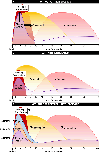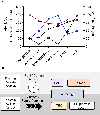Variable Response to Antifibrinolytics Correlates with Blood-loss and Transfusion in Posterior Spinal Fusion
- PMID: 35247191
- PMCID: PMC9891390
- DOI: 10.1007/s43390-022-00489-6
Variable Response to Antifibrinolytics Correlates with Blood-loss and Transfusion in Posterior Spinal Fusion
Erratum in
-
Correction to: Variable Response to Antifibrinolytics Correlates with Blood-loss and Transfusion in Posterior Spinal Fusion.Spine Deform. 2022 Jul;10(4):853. doi: 10.1007/s43390-022-00507-7. Spine Deform. 2022. PMID: 35416625 No abstract available.
Abstract
Purpose: Posterior spinal fusion (PSF) activates the fibrinolytic protease plasmin, which is implicated in blood loss and transfusion. While antifibrinolytic drugs have improved blood loss and reduced transfusion, variable blood loss has been observed in similar PSF procedures treated with the same dose of antifibrinolytics. However, both the cause of this and the appropriate measures to determine antifibrinolytic efficacy during high-blood-loss spine surgery are unknown, making clinical trials to optimize antifibrinolytic dosing in PSF difficult. We hypothesized that patients undergoing PSF respond differently to antifibrinolytic dosing, resulting in variable blood loss, and that specific diagnostic markers of plasmin activity will accurately measure the efficacy of antifibrinolytics in PSF.
Methods: A prospective study of 17 patients undergoing elective PSF with the same dosing regimen of TXA was conducted. Surgery-induced plasmin activity was exhaustively analyzed in perioperative blood samples and correlated to measures of inflammation, bleeding, and transfusion.
Results: While markers of in vivo plasmin activation (PAP and D-dimer) suggested significant breakthrough plasmin activation and fibrinolysis (P < 0.01), in vitro plasmin assays, including TEG, did not detect plasmin activation. In vivo measures of breakthrough plasmin activation correlated with blood loss (R2 = 0.400, 0.264; P < 0.01), transfusions (R2 = 0.388; P < 0.01), and complement activation (R2 = 0.346, P < 0.05).
Conclusions: Despite all patients receiving a high dose of TXA, its efficacy among patients was variable, indicated by notable intra-operative plasmin activity. Markers of in vivo plasmin activation best correlated with clinical outcomes. These findings suggest that the efficacy of antifibrinolytic therapy to inhibit plasmin in PSF surgery should be determined by markers of in vivo plasmin activation in future studies.
Level of evidence: Level II-diagnostic.
Trial registration: ClinicalTrials.gov NCT03741023.
Keywords: Antifibrinolytic; Elective surgery; Plasmin activity; Posterior spinal fusion; TXA.
© 2022. The Author(s), under exclusive licence to Scoliosis Research Society.
Conflict of interest statement
Figures






References
-
- Kannan S, Meert KL, Mooney JF et al. (2002) Bleeding and coagulation changes during spinal fusion surgery: a comparison of neuromuscular and idiopathic scoliosis patients. Pediatr Crit Care Med 3(4):364–369 - PubMed
-
- Goobie SM, Zurakowski D et al. (2018) Tranexamic acid is efficacious at decreasing the rate of blood loss in adolescent scoliosis surgery: a randomized placebo-controlled trial. J Bone Jt Surg Am 100(23):2024–2032 - PubMed
Publication types
MeSH terms
Substances
Associated data
Grants and funding
LinkOut - more resources
Full Text Sources
Medical
Research Materials
